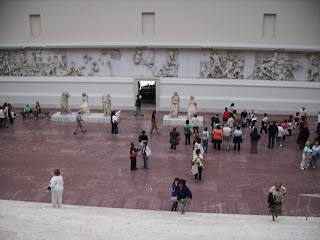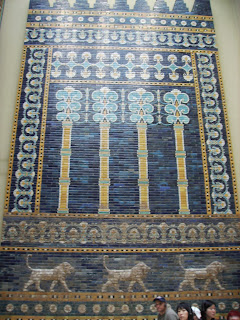The Pergamon Museum is THE reason why you should visit Berlin (otherwise, a pretty dreary city). I don't even want to think about the fact that we should be visiting the actual town of Pergamon instead, but, I have to admit, Berlin is far easier to reach. And, while I agree that the German archaeologists made massive contributions to the wold's heritage, it's still a bit unsettling to see entire walls and buildings relocated inside the Berlin museum.
Located on Berlin's museum island, the Pergamon Museum opened for the general public in 1930, and, despite suffering serious damage during the Second World War, it's still a safe place for some of the most impressive masterpieces from several areas.
The Pergamon Altar
As the name implies, this is the reason why the museum was built in the first place, to provide a proper setting for the display of the massive Pergamon frieze.
In judging the value of the structure from Pergamon, you have to keep in mind that its basic function was propaganda. It was built by the Attalid dynasty, after a series of military successes, to consolidate and justify their position in the area, and to overshadow the previously dominant Seleucids. That being said, it's not beautiful or inspirational, it's just huge.
So, the frieze stays away from any controversial or confusing subjects, and depicts one of the most popular theme for monumental art in classic Hellenistic history: the gigantomachy, the fight between giants, generic representatives of the forces of chaos and destruction, and the Olympian gods aided by Hercules, as defenders of order and stability.
The gigantomachy theme, besides various representations on pottery, can also be found on the east metopes of the Parthenon and on several friezes from Delphi. All in all, a pretty “safe” theme to go with, especially as it offers generous options to the artists working on it.
The names of the sculptors who worked on the giant frieze from Pergamon did not survive to this day; however, scientists generally agree that the general plan was the work of just one man, who did everything in great detail, insuring the individual appeal of each group, different hairstyles and clothes for each figure, and so on.
Detail of the floor mosaic from the Pergamon altar
There's a secondary frieze on the altar, from the inner courtyard, the Telephos frieze. A lot smaller than the gigantomachy, I found it to be more interesting. First, the theme is not as common – it's the story of Telephos, son of Hercules, mythical founder of Pergamon. And second, it includes some innovations that made career in the following centuries, such as very detailed landscape, and the inclusion of details, such as furniture, when the action on the panel took place indoors. That's a great source of information about how people actually lived in those days.
The Ishtar Gate
Built in about 575 BC by King Nebuchadnezzar II in Babylon, the Ishtar Gate was considered one of the seven wonders of the world in antiquity, until it got booted off the list by the great lighthouse in Alexandria.
The Pergamon Museum displays only the smaller, frontal part of the gate, while keeping the rest in storage for the time being. As the authorities announced plans to add new buildings to the museum in the near future, we can only hope that we'll get to see the full beauty of the Ishtar Gate soon.
The glazed bricks that decorate the gate and the processional way depict a variety of creatures, and museums all over the world took a bite, with dragons being the rarest (you can find them in the museums in Istanbul, Gothenburg and Detroit) and lions the most common.
The Market Gate of Miletus
Had enough of gates and walls? Well, it's worth checking out the market gate of Miletus, just to think if you know any entrances into today's malls that could make it into the history museums of the future. I wish we could ask people from 120 AD whether the addition of the new gate had any impact on their spending habits and increased their interest and consumer confidence.










